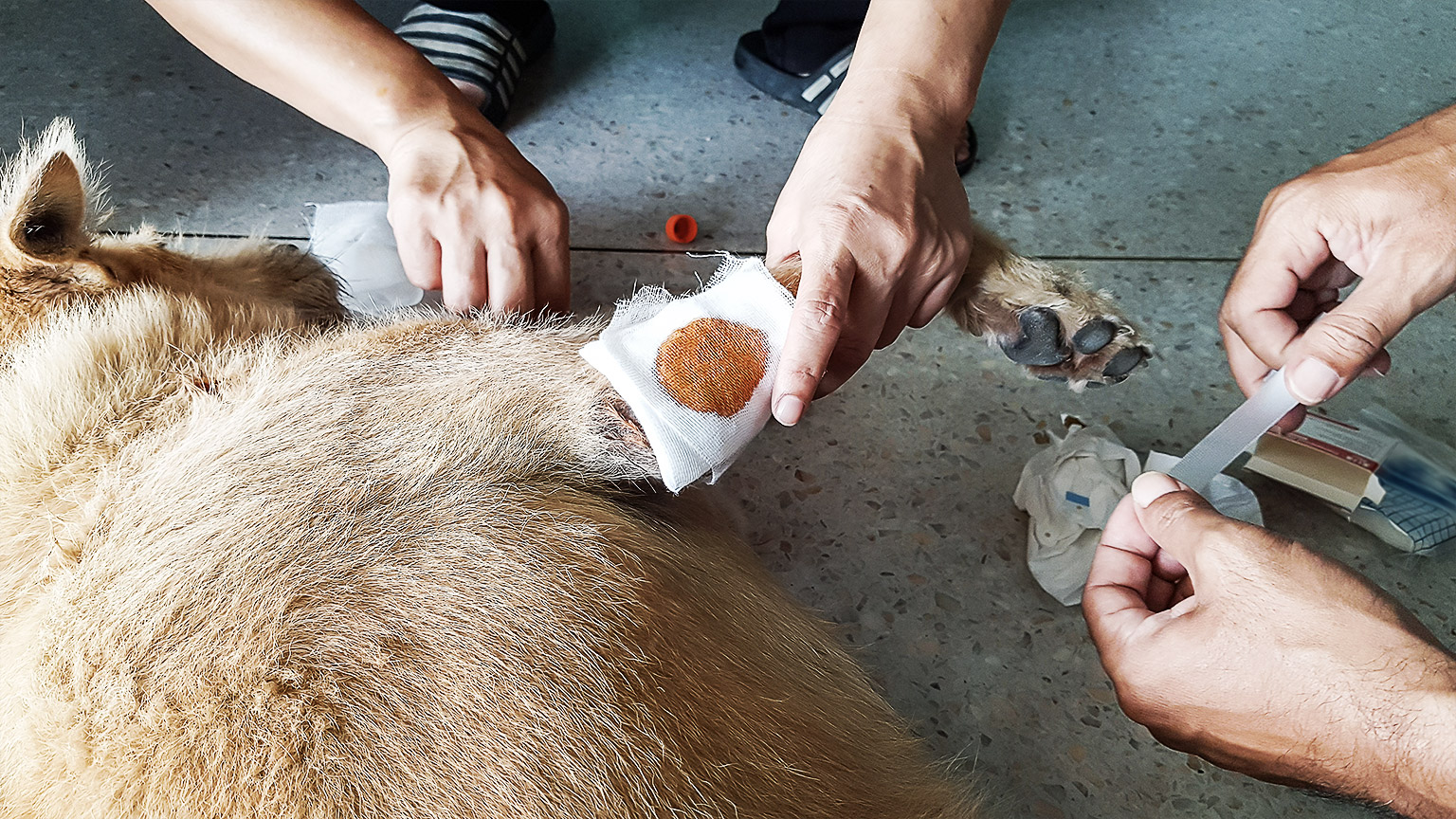Once you have assessed the physical condition and vital signs of the animal, you can decide which first aid techniques are appropriate for the situation.
If an animal requiring first aid is brought to you at your workplace, you should have all the relevant equipment easily available. However, in the field you may need to be creative. It may be a good idea to carry an animal first aid kit with you when you are out and about, so that you can be better prepared in case of an emergency. The following list outlines some key items that you should include in your first aid kit.
First Aid Kit Checklist:
- Slip lead × 2
- Disposable gloves$
- Clippers/shearers
- Thermometer
- Sterile rinse solution (saline) (wound wash)
- Towel or blanket to use as a stretcher
- Gauze swabs
- Stretchy bandage
- Bandage scissors (blunt ended)
- Tweezers
- Tick tweezers
- Hand sanitiser
- Non-stick sterile wound dressing
- Splinting item, a ruler for example
- Self-adhesive tape, including packaging tape
- Conforming bandage (stretchy gauze)
- Foil blanket
- Antiseptic wipes
- Cotton wool
- Box or cat cage – you can store all items neatly in it and use for transporting of animals.
Basic animal first aid techniques
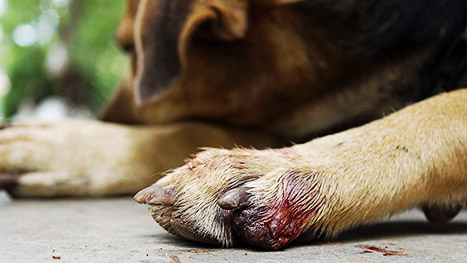
Basic first aid, whether it is for native animals, domestic animals or people is very similar. By applying the basic first aid treatment principles, you might just be able to save an animal's life. Remember though, first aid does not treat the animal. It just maximises the chance of survival until a vet can attend the animal.
Recall the seven principles of first aid:
- Preserve life
- Prevent deterioration
- Promote recovery
- Take immediate action
- Calm the situation down
- Call for medical assistance
- Apply the relevant treatment.
There are many different first aid techniques you can use. The techniques you choose will depend on the situation and your physical condition and vital sign assessment of the animal.
There are several first aid practices you may become aware of at your clinic or animal care workplace. Speak to your supervisor to determine and understand workplace specific procedures relating to first aid.
However, in this module, we will focus on five of the most common basic techniques that you are likely to use:
- Check and clear airways
- Control bleeding
- Minimise the impact of shock
- Immobilise limb injuries
- Apply water for burns and heatstroke.
Check and clear airway
Oxygen is critical for survival. If an animal can’t breathe effectively, it will likely die within a few minutes.
If at any point you are concerned the animal isn’t breathing well, for example you can hear gasping or bubbling sounds as they breathe, check its airway to ensure there is no obstruction (something blocking the airway). If you see something you will need to remove the obstruction to clear the airway and allow the animal the best opportunity to breathe.
To check and clear the airway:
- Position yourself on one side of the animal
- Place one hand across the top of the animal's muzzle and slide your thumb and index finger gently into the mouth, between the teeth.
- As the top and bottom teeth separate, insert the pointer finger of your other hand between front incisor teeth, apply pressure to bottom jaw and tongue to open the mouth fully.
- Look inside mouth and as far down the throat as you can.
- If necessary, use a sweeping motion with your pointer and middle fingers across the tongue to remove excess saliva.
- If you see an obstruction and can clearly see the entire object (in other words from start to finish), you can use your fingers or tweezers to remove the object carefully. When using tweezers, be extremely cautious in case you injure the mouth or throat. If the object is too far in or you cannot see how far down it goes, do not attempt to remove it. Removing obstructions like this may cause further injury or bleeding. Immediately take the animal to a vet.
- If you have access, administer oxygen. This can be done by simply holding the oxygen tubing close to the animal’s face – fly-by O2. You can also use an oxygen face mask, hood or tent for a more direct delivery of oxygen.

Watch the following the video, 'How to Help a Choking Dog’ (3:03 min), which demonstrates how to check and clear the airways of a choking dog.
Read the article, ‘First aid for pets struggling to breathe’, to learn about what to do if an animal is having difficulty breathing.
Control bleeding
If you see blood, check the animal for wounds. Where blood is oozing or only dripping slowly, such as from a graze or a scratch, clean the wound and apply a clean dressing or bandage.
Review the video ‘direct digital pressure’ (1:59 min) to learn how to apply direct digital pressure to a minor bleed.
Video transcript
Direct digital pressure (2:00 min)
Title slide: ‘Otago Polytechnic School of Veterinary Nursing’
Slide text
First aid: Direct digital pressure (used for minor wounds
IMPORTANT
Before approaching assess the animal’s demeanour
If you are unsure consider applying a muzzle
[Video shows dog’s left-hand paw with several spots of blood on it]
You will be using your fingers (digits
To put direct pressure on the wound
[Video shows gloved hand and three middle fingers putting pressure on the bloodied spot on dog’s paw
Notice the nurse is wearing gloves
This helps reduce the risk of contamination
[Video shows ungloved hand putting pressure on the same wound]
You can still apply pressure if you don’t have gloves
Try to make sure your hands are clean though
[Video shows a gloved hand applying a piece of cloth over the wound and applying light pressure]
You can also use a swab
Or a clean household cloth
Apply pressure for up to 15 minutes
Minor bleeding should clot in that time
[Video shows gloved hand slightly pinching together the paw wound with nail and forefinger]
You can also pinch the edges together
Again hold for up to 15 minutes
What if there’s glass in the wound?
[Video shows gloved thumb and forefinger lightly pinching same dog’s paw wound together]
Use the pinch method
leave the glass in the wound
Or apply a pad either side of the glass
And bandage around the glass
IMPORTANT
[Video shows original image of dog’s bloodied paw]
This technique is only useful for minor wounds
if blood flow is heavy or spurting use a pressure bandage
Don’t remove any foreign objects (like glass) form the wound
it might be preventing arterial bleeding
Avoid putting pressure on a foreign object
you might push it further in
Minor bleeding should stop within 15 minutes,
if it hasn’t consider a pressure bandage
Make sure the animal is seen by the veterinarian
even for minor bleeding (could be complications)
Thanks To
Hannah as the Nurse
Fin as Himself
Animal injuries simulated
[Slide shows Otago Polytechnic Te Kura Matatini ki Otago logo]
[End of video and transcript]
If you see blood steadily dripping or spurting, the animal is at risk of excess bleeding. Excessive blood loss is very dangerous for an animal because it means that its organs and tissues won’t receive enough oxygen or nutrients to function properly. An important step in first aid is to control bleeding – slow or stop the bleeding.
To control bleeding of laceration on the hindlimb of a dog:
- Appropriately restrain the animal.
- Apply firm pressure to the wound for at least 3 minutes, using a clean towel, swab, dressing or bandage.
- If the blood soaks through the first dressing, add another. Do not remove the first dressing in case it disturbs a clot that is forming and reopens the wound.
- Secure dog in vehicle ensuring it is adequately restrained and cannot tamper with the dressing or cause further injury to itself.
- Transport the animal to a vet when safe to do so.
Watch the following video, ‘Pet First Aid: How to Stop Bleeding’ (2:29 min), for some basic techniques to help stop and control bleeding.
Read the article, ‘First aid for bleeding’, to learn about what to do if an animal is bleeding.
Minimise the impact of shock
Shock is an emergency medical condition that is caused when the body’s ability to circulate blood efficiently is disrupted. As a result, blood flow and oxygen delivery to vital organs is reduced. There are several causes of shock, including blood loss, heatstroke, burns or severe infection. As with difficulty breathing or excessive bleeding, shock means that tissues and organs are not getting enough oxygen and nutrients to function effectively.
As an animal first aider, to minimise the impact of shock:
- Remain calm yourself, and try to keep the animal quiet and calm and by:
- Using low stress handling techniques, such as handling with a towel
- Keeping the animal away from noise and activity as much as possible
- Keep the animal warm
- If available, administer oxygen.
Watch the following video, ‘Basic Animal First Aid’ (5:51 min), which explains how to recognise and treat shock in animals.
Immobilise limb injuries
Immobilising a limb (keeping the limb still) will help prevent additional injury from occurring. Immobilisation is useful for all types of limb injury, but critical for broken bones.
In the case of fractures or other limb injuries, most animals will hold the affected area up and will not put pressure on it. Some will place pressure on it but limp or whine or make other sounds indicative of pain.
There are two main types of fractures.
- A closed fracture occurs when a bone is broken, but the skin is intact. You may notice swelling or abnormal movement of the limb.
- An open fracture (or compound fracture) is when a broken bone is accompanied by an open wound. The wound is often caused by the broken bone breaking through the skin.
Immobilise the limb
If you suspect or observe soft tissue damage or a bone fracture, and it is safe for you to do so, immobilise the limb using bandaging.
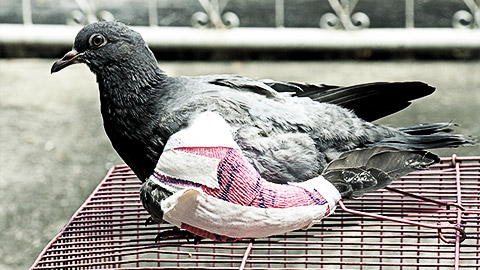
You can use the following steps to immobilise the limb.
- Firstly, do not pull on the limb. Do not try to straighten the limb or the broken bone. This will only cause pain and more injury.
- Attend to any bleeding.
- Try to limit the animal’s movement of and pressure on the limb. If possible, elevate the limb with a pillow, towel or suitable alternative.
- When transporting the animal to a vet, provide additional padding to reduce any movement while in transit.
Study the following video, ‘Dog and Puppy First Aid : Fractures’ (0:37 min), which demonstrates how to provide basic first aid for a dog with a broken bone.
Read the article, ‘First aid for broken bones’, to learn about what to do if you suspect the animal has a broken bone.
Apply water
Clean water is very useful in the basic first aid of animals. You can use water to clean the animal or area as well as to cool the animal. Water is particularly important in the first aid treatment of burns and heatstroke.
Burns
Burns rapidly cause soft tissue damage, typically to the skin of the animal. Burns may be caused by:
- Fire or very hot objects
- Electricity
- Sunburn
- Very hot water or steam
- Chemicals.
Visible signs of a burn may appear immediately or can take 12-24 hours to appear after the incident, depending on the cause and severity of the burn. The symptoms of a burn depend on the severity of the injury.
- First degree burns only affect the top lay of the skin. Symptoms are typically:
- redness
- pain.
- Second degree burns affect the top two layers of the skin. Visible signs include:
- red, white, or blotchy skin
- swelling
- blisters.
- Third degree burns affect the tissue underneath the skin and may cause nerve damage. Visible signs include:
- exposed tissue (missing skin)
- bleeding
- burnt areas may appear brown, red, or white (Mayo Clinic Staff n.d.).
Regardless of the severity of the burn, cool the area immediately by:
- Applying cool running water to the area or immerse in cool water for a minimum of 10 minutes, for example by placing the burnt area under a running tap or shower. The longer the better.
- Applying a cool pack or cool wet compress to the area for a minimum of 30 mins. Note do not place the cold pack directly on the skin, always wrap it in a clean cloth.
Note: use cool water, not ice. Ice can cause further damage to burnt tissue.
Read the article, ‘First aid for burns’, to learn about what to do if the animal is burnt.
Another injury to consider with fire burns is the possibility of smoke inhalation. Document your concerns if you have them, so the vet can treat the animal appropriately if required.
Heatstroke
Recall that heatstroke is another term used for hyperthermia, which results from body temperature exceeding the normal range.
As with applying water for burns, use cool rather than cold water. A rapid decrease in temperature will cause blood vessels to constrict, reducing blood flow, which will prevent the animal from cooling.
To provide first aid to an animal for heatstroke:
- Remove the animal from the hot environment
- Gradually lower the animal’s body temperature using one or more of the following techniques:
- Apply cool water from a tap to the skin, especially around the groin, armpits and neck
- Place the animal under cool (not cold) running water
- Place the animal in front of a fan or air conditioner
- Move the animal to a shady or air-conditioned area
- Wet the area around the animal to lower the ambient temperature
- Assess animal's core temperature regularly (every 5 minutes) while actively cooling; keep your supervisor informed of animal’s temperature and stop active cooling techniques when advised by them.
It is possible to cause hypothermia and the animal becoming too cold if active cooling continues, hence it is essential to be in constant communication with your supervisor.
Study the following video, ‘Dog first aid: heatstroke’ (6:44 min), which explains how to detect if a dog has heatstroke and what to do.
Read the article, ‘First aid for heatstroke’, to learn about what to do if the animal is suffering from heatstroke.
Tick paralysis
Ticks are a type of ectoparasite and feed on the blood of other animals. Some species of tick can cause paralysis by injecting a toxin not the animal as they feed.
If you find a tick on an animal during your assessment, remove it using tweezers or a dedicated tick removal device by twisting and plucking. Make sure you remove the entire tick, including the head (it often snaps off during removal). Keep the tick in a jar to have the vet positively identify it.
Ticks will drop off by themselves once they had fed enough. Once the tick is gone, the animal may or may not show signs that it had a tick attached. If the hind legs of the animal are not coordinated, this may progress to paralysis. The animal may hyperventilate (breathe too quickly), have a change or loss of voice, have no appetite, vomit or regurgitate.
If you suspect tick paralysis, urgently seek veterinary assistance, no matter what degree of the signs.
While awaiting help, to manage the animal, make sure you:
- Don’t give them any food or water.
- “Keep the animal quiet, free from stress and excitement.
- Keep the animal in a temperature-controlled environment” (Australian Tick Paralysis Advisory Panel, 2016).
The size of the tick does not determine the possible severity of the outcome – both small and large paralysis ticks are potentially lethal. The tick may not be obviously visible on the animal, for example they may be located in the ear or under the lip in the gum.
Cats with tick paralysis have several unique additional treatment considerations which are different to dogs. According to the Australian Tick Paralysis Advisory Panel (2016), they are to:
- Handle away from dogs to reduce stress
- Cats are more likely to have an anaphylactic reaction to tick antitoxin serum (TAS) than dogs
- Treat in a quiet, dark, temperature-controlled environment
- Supplement oxygen if indicated using an oxygen cage.
Review A Guide to Diagnosis, Management, Treatment and Prevention (pdf) for comprehensive information about paralysis ticks in cats and dogs.
Other first aid techniques
Read the ‘Initial treatment and care guidelines for rescued possums and gliders’ from the NSW Government for specific information about common first aid requirements of these Australian marsupials.
The following table outlines some other first aid situations and the relevant procedures. Select the links to extend your knowledge.
| First aid situation | Procedures | Additional resources |
|---|---|---|
| Tick toxicity |
|
|
| Snake envenomation |
|
|
| Cardiac arrest |
|
|
| Ingestion of toxins |
|
Transport the animal safely
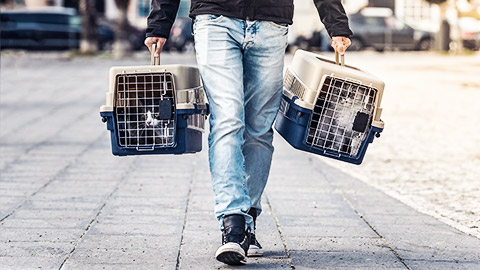
Once you have provided first aid to the animal, you must then transport it to the veterinary facility for full treatment.
Moving and transporting an animal is risky because it can cause injury to both the animal and the first aider if not done appropriately. Unless the animal is present at an animal clinic or hospital, you will likely need to move the animal into a vehicle, then transport it to a veterinary facility.
In many first aid situations, the animal should not be encouraged to walk to the vehicle. They should be carried. So, remember your manual handling techniques and take care when you pick up and carry an animal. Ask for assistance to move large, heavy, awkward or aggressive animals.
The specific techniques needed to move and transport the animal will depend on the species involved. For example, a possum could be transported in a hessian bag, while an injured horse may require a horse float. However, two key aspects to consider when transporting an injured or ill animal are:
- Minimising movement and providing support to reduce further injury
- Reducing stress.
If possible, call ahead to make sure the veterinary facility knows you are on your way and are ready for the animal’s arrival.
Minimise movement
When moving the animal, motion of the head, neck, and spine should be minimized.Linklater A., 2020
If you suspect spinal injury or are not confident about transporting the animal, do not attempt to move the animal until you have spoken to a vet.
As a rough guide, if the animal weighs more than about 15 kg, ask for assistance to move them (pdsa 2020). Where possible, use a flat, firm surface, such as wood, thick cardboard or thick material, as a stretcher to provide support to the animal as you move it. It may be appropriate to strap the animal to the stretcher. X-rays will pass through most non-metallic materials, which means the animal won’t need to be moved once it arrives at the clinic or hospital (Linklater A. 2020).
The following steps are a general guide to moving an injured animal into a vehicle. Specific situations may require different techniques.
- Throughout the process, talk calmly and reassuringly to the animal.
- Support the head, neck and back by placing one arm under their head and shoulder and the other under their pelvis. Two people may be required to lift larger animals.
- Slowly and smoothly, with no jerky movements, lift the animal onto the support. When choosing a stretcher, make sure it is large and strong enough to support the whole animal.
- Check the path to the vehicle is clear and safe.
- Get a firm grip on all four corners of the stretcher if you are transporting a small animal. If two or more people are required to lift the animal, make sure everyone involved has a clear understanding of their role in the process so you can work together.
- Bend your knees and slowly life the animal by the stretcher.
- Walk slowly to the vehicle trying not to jolt the animal.
- Place the animal in the vehicle and secure them with seatbelts, towels, or clothing to provide padding so they do not move around during transport (pdsa 2020).
“Animals with altered mentation after trauma should be transported with the head level with the body or elevated 20 degrees. There should not be any jerking or thrashing motions, and manipulations of the neck or occlusion of the jugular veins should be avoided” (Linklater A. 2020).
Examine the following video, ‘Getting a dog safely in and out of the car’ (1:57 min).
Minimise stress
Ill and injured animals are at risk of shock. The additional stress of being moved and transported increases that risk. So, it is critical that you try to minimise this risk as much as possible through handling them animal as little passible and by using appropriate handling when you do. Be aware of where the pain or injuries are and do not touch the animal in that area.
An understanding of additional stressors for specific species can help. For example, “cats can be placed in dark boxes to minimize stress during transport; the box should have holes large enough so that the cat can be observed and to allow adequate fresh air” (Linklater A. 2020).
Wrapping or padding the animal with towels or blankets helps to keep the animal warm, reducing the impact of shock, as well as supporting them and protecting them from jolts during transport. However, consider the ambient temperature of the vehicle. You may need to turn on the heating or air conditioning to make sure the animal does not suffer hypothermia or heatstroke.
Minimising noise (turn the radio off in the vehicle) and making it dark for the animal, such as placing the animal in a dark room or placing a cover over their box can also help reduce the animal’s stress and impact of shock. However, make sure the animal always has access to fresh air. Do not cover the animal’s head at all if they are not breathing well.
Review How to safely move an injured pet (pdf) for great tips on handling to avoid further injury during transportation of the patient.
First aid assistance
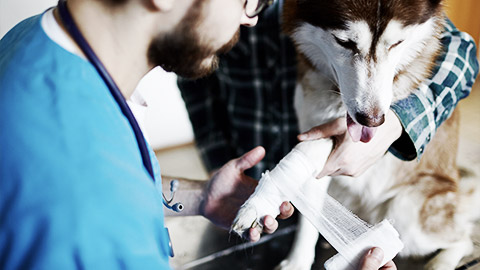
It is critical that you seek assistance with providing first aid to animals if you require it. A medical emergency is not the time to guess or struggle on your own. Persisting without assistance may result in further injury to the animal, or harm to yourself.
Some reasons for seeking assistance may include asking for:
- advice about a first aid treatment
- advice about a specific animal such as a native animal or exotic pet
- help moving a large or heavy animal
- help securing or restraining an animal
- someone to direct traffic
- assistance with a first aid treatment you are not qualified to administer, such as CPR.
Where to seek first aid assistance
The type of assistance you need will depend on the emergency at hand, the species of animal and the location of the incident. For example, if the patient presents at a veterinary clinic, you will have vets and vet nurses on had to assist and give advice. However, if you are in the field or somewhere with limited access to medical supplies and equipment, you may need to rely on phone calls to professionals or the general public for assistance.
Qualified assistance
Regardless of whether the incident takes place in an animal medical facility or not, you can seek qualified assistance from people who are trained in animal medical care. If they are available in person, such as the vet doing routine health checks in a stable, speak to them directly. They will be able to provide you with both verbal advice and hands-on assistance if you require it.
If no qualified staff are present, you can simply call them. A mobile phone is a critical piece of equipment for first aid. People you can call in an emergency include, but are not limited to:
- your supervisor
- a veterinary
- an animal hospital
- a registered wildlife carer or care facility
- rangers
- state and local government emergency services
- animal welfare bodies and support facilities.
Who you should call will depend on the specific situation. It’s a good idea to keep relevant numbers on speed dial and/or attached to your first aid kit for easy reference. Remember, that if you are travelling to a new location, look up and record the animal emergency numbers specific to that area before you leave. It will save precious time should you need to contact any of them. Phone numbers for local wildlife rescue and care facilities are often displayed on road signs.
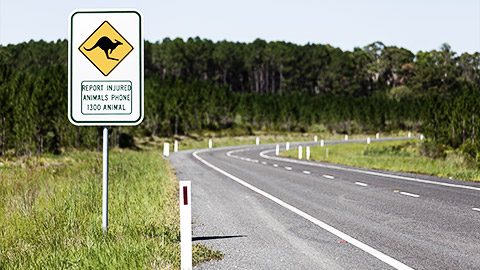
At the very least, you will need to notify the animal medical facility that you will arrive with a patient and provide them with the specific information relevant to the situation. Every animal must be attended by a veterinary following first aid treatment, regardless of the type of emergency.
Animal emergency network contact details
There are many different animal care facilities across Australia that make up the animal emergency network. It is important to be familiar with the emergency care facilities in your local area. The following table described the five main types of animal emergency network organisations and includes an example of each type.
| Animal emergency network | Description | Example |
|---|---|---|
| Veterinary services | During business hours, all veterinary clinics will provide advice for first aid emergencies and receive emergency patients if they are equipped for the species and specific emergency. | Kings Road Veterinary Surgery Phone: (07) 4772 4189 After Hours: 0455 420 807 Shop 3, 36 - 48 Kings Road, Hyde Park, QLD, 4812 https://kingsroadvetsurgery.com.au/ |
| Emergency and after-hours veterinary clinics | These clinics specialise in emergency treatments and are staffed outside of normal business hours, sometimes 24-hours a day | Perth Vet Emergency Phone: 1300 040 400 Unit 3, 162 Wanneroo Road, Yokine, WA, 6060 https://pve.net.au/ |
| Wildlife rescue and care facilities | Many normal veterinary clinics are not equipped to care for wildlife. Wildlife rescue and care facilities and registered wildlife carers are trained and experienced with the specific care needs of Australian wildlife | NSW Wildlife Information Rescue and Education Service (WIRES) Wildlife Rescue Line: 1300 094 737 https://www.wires.org.au/contact/contact-us |
| Animal welfare bodies and support facilities | Animal welfare bodies provide advice and guidance regarding breaches of the animal welfare principles. You may need to speak to one regarding an animal you suspect of being abused or neglected | RSPCA South Australia 24-hour hotline: 1300 477 722 https://www.rspcasa.org.au/ |
| State and local government emergency services relevant to animal incidents | State and local governments have emergency phone numbers to report animal incidents or call for emergency services relating to animals. | Wildlife Victoria – report a wildlife emergency form https://www.wildlifevictoria.org.au/wildlife-information/report-a-wildlife-emergency |
Veterinary clinics are quite common in urban areas and medium to large rural towns but may be rarer in remote areas. Wildlife rescue organisations tend to be state- or territory-based. Some examples of wildlife rescue centres include:
- WIRES (New South Wales and Australian Capital Territory)
- Wildlife Rescue Queensland
- Australian Wildlife Health Centre (Victoria)
- Foundation for National Parks and Wildlife (South Australia)
- Native Animal Rescue (Western Australia)
- Bonorong Wildlife Rescue (Tasmania)
Activity – your local animal emergency network
Research the contact details for the following types of emergency animal care facilities. Record the information in your phone, on a card in your car or attach it to your first aid kit.
| Animal emergency network | Name of local organisation | Phone number | Physical address | Website URL (if applicable) |
|---|---|---|---|---|
| Veterinary clinic A | ||||
| Veterinary clinic B | ||||
| After hours/emergency veterinary clinic A | ||||
| After hours/emergency veterinary clinic B | ||||
| Wildlife rescue and care A | ||||
| Wildlife rescue and care B | ||||
| Animal welfare body A | ||||
| Animal welfare body B | ||||
| Local government animal incident emergency services |
Unqualified assistance
You can also seek assistance from unqualified people, such as the owner of the animal or even people passing by. However, you would not seek advice from unqualified people. Rather, you would ask for physical assistance with handling or providing first aid to the animal.
The importance of oral communication skills
When asking for advice or physical assistance, recall your active listening and other communication skills from earlier in this module.
- Speak clearly and calmly
- Be specific about the assistance you require:
- Do you need advice? What specific information do you need?
- Do you need hands-on assistance? What specific task do you need the other person to do?
- Actively listen to the responses from the person you are seeking assistance from:
- Do they understand the assistance you require?
- Do they have any questions for you?
- Do you understand the advice they are providing?
- Do you have any other questions?
Knowledge check 6

Keep relevant staff informed about the animal’s condition
After administering first aid, you should monitor the animal and keep your supervisor, veterinarian or other appropriate personnel informed about their condition. If you notice any changes in the animal’s condition, especially any deterioration in the condition, you must report it immediately.
The three general updates regarding animal condition are:
- Deterioration (getting worse)
- Improvements (getting better)
- No change.
While verbal updates may be appropriate, you should also record all observations and interactions with the animal.
These records must be concise and accurate noting all the relevant details in the appropriate locations. Forms must be completed in full and should be safely stored in the appropriate area.
When communicating verbally, make sure to speak clearly and calmly. However, do not downplay the seriousness of the situation, particularly if the animal’s condition is worsening and they need immediate veterinary attention.
Recall the different levels of emergency. If your first aid treatment stabilises the animal, the emergency may be downgraded. However, if the animal starts to deteriorate or you notice a new symptom, the emergency may be upgraded to a life-threatening situation. You must inform your supervisor or the vet that they need to attend the animal immediately.
Recording information about the animal or incident
Every animal care facility will have different methods and technology for recording information. You will need to learn the procedures and systems that relate to your organisation in terms of what information should be recorded, as well as how and where. These instructions should be provided to you upon induction. If you are at all unsure of the requirements relating to recording procedures, systems and/or technology, discuss these with your supervisor. Your organisation should also keep up to date policies and procedures relating to health and safety and emergency situations.
What information to record
The type of detail you need to record will depend on your workplace procedures. For example, the details of the first aid treatment you provided, which you need to record may be different if you are working in a boarding facility compared to if you are working in a veterinary clinic. You may be required to complete an incident report or contribute to the medical records of the animal. As always, follow the procedures of your specific workplace.
Remember that the point of recording information is to allow anyone who reads it the ability to “understand what took place and why” (Risk HQ n.d.). So, make sure the information you include is relevant and concise, while being detailed enough to describe the situation properly.
You should also ensure that all information is recorded:
- Accurately
- Objectively (in other words, factually without including emotive language or personal opinion)
- Using appropriate industry terminology and abbreviations.
Incident reporting
Information collected about the animal incident may be helpful in preventing a similar incident in the future. Follow your workplace recording and emergency procedures regarding the specific information you need to record about the incident.
Common details include:
- The date, time and location of the incident (location is particularly important for wildlife rescues so that animal can be returned to the same location)
- The name, species, sex and age of the animal involved
- Details of the injury or illness
- Details about the first aid treatment that was given
- Details about what happened to the animal after first aid treatment (for example, stayed at home or attended local veterinary or emergency clinic)
- Name and signature of the first aider (RT Training n.d.).
Medical records
After providing basic first aid to animals, you may need to ensure you accurately record any treatment provided to the animal along with any other observations or additional information relevant to the treatment of the animal.
Medical records must be concise and accurate, noting all the relevant medical details in the appropriate sections. Forms must be completed in full and should be safely stored in the appropriate area.
Your workplace may have a specific first aid incident report form. However, if you don’t have access to a form, include the following details in your medical records:
- Assessment of physical condition:
- Breathing
- Demeanour
- External injuries
- Hydration status
- Ambulation
- Assessment of vital signs:
- Temperature
- Heart rate
- Pulse rate
- Respiratory rate
- Mucous membranes
- Any known allergies or medications
- Any known medical history
- Description of signs and symptoms
- Description of the first aid treatment(s) provided.
You are likely to assess the animal’s vital signs repeatedly during its first aid treatment, transportation and monitoring. You may find it easiest to record these data in a table, such as the one following, noting the times at which you assessed them.
| Time | Temperature (°C) |
Heart rate (bpm) |
Pulse rate (bpm) |
Respiratory rate (bpm) |
CRT |
|---|---|---|---|---|---|
Other records
Another place you may need to record information about the incident or the animal is a surrendering form for wildlife, strays or other rescued animals. The following is an example of a typical wildlife surrender form.
| Wildlife Surrender Form | |
|---|---|
| Your details: | |
| Title | Ms |
| First name | Vivian |
| Last name | Nguyen |
| Contact number | 0401 222 333 |
| Rescue location: | |
| Street number | |
| Street name | Lower Dandenong Road |
| Suburb | Braeside |
| Postcode | 3195 |
| Is this your home address? (Y/N) | N |
| Is this where you found the animal? | Y |
| Any other details | Found on the verge between the northern boundary of Braeside Park and the road |
| Animal rescue details: | |
| Species/breed | Wombat |
| Description of the animal's condition |
|
| Description of first aid provided | Bleeding controlled with bandages, kept warm. |
Knowledge check 7

Pablo the dog
| Animal name: Pablo Owner name: Brown Owner number: 0400 100 100 |
Species: Canine Breed: Beagle Age: 4 months Life stage: Puppy |
Colour: Black and tan Sex: Male; entire Weight: 4.2 kg |
Heath problem: Suspected closed fracture and spinal injury.
Sarah works at ABC Kennels and works in the doggie daycare room.
Two large dogs were playing roughly when Pablo joined in. One of the larger dogs fell awkwardly on to Pablo. Sarah heard a loud squeal and saw Pablo lying on his side when the larger dog moved away.
After calling for assistance to manage the other dogs in the play area, Sarah quickly assessed Pablo’s condition. He was panting and whining quietly, she also observed that he was shivering and lip smacking. He also made no attempt to stand. When feeling his limbs, Sarah saw Pablo noticeably flinch when she touched his back right leg.
Concerned he may have also hurt his spine, Sarah did not encourage Pablo to stand and, although he was small enough for her to easily pick up and carry, she decided it would be safer for him to use a stretcher.
Once Sarah had moved Pablo out of the play area and into the first aid room, she applied a conforming bandage to his injured leg and called the veterinary clinic. While she was waiting for the veterinarian to arrive, Sarah stayed with him keeping him calm by reassuring him in a gentle voice and made sure he was comfortable and warm.
Well done! You have now completed the theory for this module. You should now have the skills and knowledge required to provide basic first aid to animals.
The key concepts from this module include how to:
- recognise if the situation is an emergency
- identify and minimise potential hazards
- approach, secure and handle the animal with appropriate equipment and low stress handling techniques
- assess the condition and vital signs of the animal
- administer basic first aid treatments
- communicate effectively with clients, and ask for assistance and advice from qualified personnel
- record relevant information.
The following links may be useful to extend your knowledge or support your interest in first techniques for animals.
- Virtual Pet First Aid Workshop (57:55 min)
- First Aid for Pets: How to Prepare for the Unexpected (1:05 hour)
- Pet First Aid
- First Aid for pets, including links to specific factsheets and downloadable checklists
